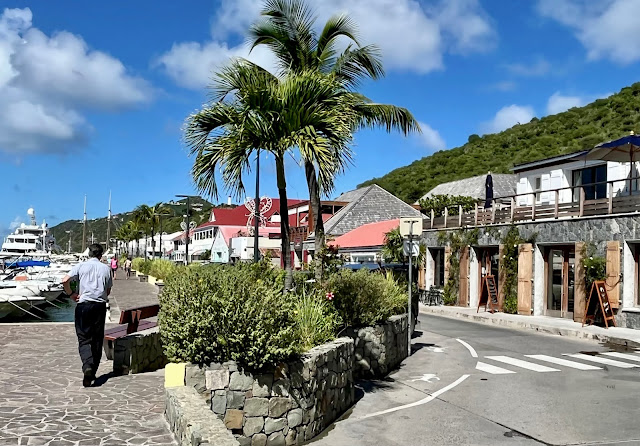Saturday, 27 November 2021
Sailing Westward to St Barts
I have been attending a series of presentations by two lecturers, one each morning and one in the afternoons. Dr Ken Beattie is not only a retired professor of botany and expert on the exotic plants of the world, but in his younger days hosted a weekly Canadian television series in which he traveled the world to all sorts of exotic places, meeting locals and sampling all sorts of strange foods--kind of an early Anthony Bourdain. He shows video samples of his early broadcasts, tells lots of (half-hearted) jokes, and in general approaches his subjects in a light-hearted way. So far, he has lectured on: Healing Plants of the Berbers; Born of Fire, Canary Islands; First Peoples of the Caribbean; Healing Ways of the Caribbean; Plants of Poor Repute.
Dr Christopher Witcombe, Emeritus Professor of Art History at Sweet Briar College in Virginia, is more formal in his presentation and presents much technical information in an interesting way: Pirates and Privateers in the Mediterranean and Caribbean; What About Atlantis; Introducing the Atlantic Ocean; Transatlantic Adventure, Conquest & Glamour; St Barts and the Caribbean.
Witcombe is especially obsessed by tectonic plates, earthquakes, and volcanoes--particularly useful information on this cruise. He presented a universally-accepted chart of volcanic intensity in active and potential eruptions that runs from zero to eight. An effusive volcano, such as Kilauea in Hawaii, ranks at zero. Cataclysmic, such as the Icelandic volcano of 2010, ranks at four. Krakatoa in Indonesia (1881), ranks at six, colossal. And the big daddy or mama of them all, ranking at 8, is the mega-colossal at Yellowstone. When that one blows (once in every 10,000 years), it will obliterate Seattle, Portland and San Francisco to the west, and everything up to and including Chicago to the east. Be very afraid.
If Yellowstone fails to blow during the next week or so, these lectures will continue on all sea days.
Sunday, 21 November 2021
Sailing Through the Straits of Gibraltar
Although I have passed through these "Pillars of Hercules" many times, the passage has always been in the dark. I did spend a day in Gibraltar while on a cruise in 2016, but this is my first day-time passage, as we continue to sail toward La Palma in the Canaries.
Riviera enters the straits at around 11am and the full passage takes about an hour. It is quite windy on deck, but temperatures are rising and I have a warm cup of cappuccino from the Baristas to keep my hands warm. There are a number of other ships, mostly cargo and tankers, sailing parallel and each is assigned a specific sea lane. The Riviera's lane is closer to the African shore than to Gibraltar, so the views are much better to the south.
Three Views of the Coast of Africa as Rivieria Sails Through the Straits of Gibraltar
After passing into the Atlantic and turning southward toward the Canaries, it's time for crew members and passengers to compete in a number of "athletic" activities on the Pool Deck--golf putting, ping pong, bean toss, etc. The games begin with the crew team parading the Oceania flag around the upper deck. Needless to say, I am an observer not a participant.
 |
| Members of the Crew Hold the Team Flag |
 |
| A Team Member Carries the Flag |
 |
| Golf Putting Competition |
For lunch--there isn't much else to report on sea days except for food, so please indulge me--the Terrace Cafe is serving an Italian buffet, along with its multitudinous regular selections. I enjoy one of the best servings of cannelloni I have had in a long time. The food is displayed as a buffet, but passengers are served by crew members; the food is kept behind heavy sheets of clear plastic. Everybody wears a mask in the food service areas.
Tomorrow is another sea day and I will continue the report on the adventures aboard the Riviera.


 \
\










__03.jpg)


















































